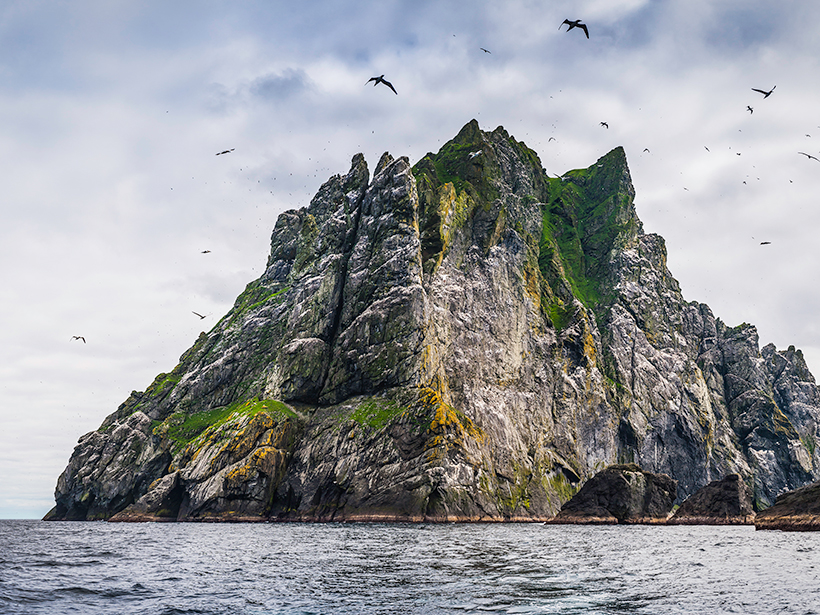An offshore island might appear to block incoming tsunami waves, but safety is far from guaranteed in an island’s shadow, new research indicates. Offshore landmasses in fact cause higher levels of wave run-up on mainland coastlines for some types of tsunami waves, according to scale model tests.
These new results have emerged from the first experimental investigation of tsunami inundation on beaches behind islands, conducted by civil engineer James Kaihatu of Texas A&M University in College Station and his colleagues.
In a sprawling, indoor laboratory in Oregon known as the Directional Wave Basin, the researchers tested artificial tsunami waves passing over and around fabricated islands and washing up on a gently sloping steel ramp that serves as the facility’s beach.
“The Directional Wave Basin is the best place to do this work,” said Kaihatu. “There’s a lot of power in the wave maker, so you can generate really nice tsunami-type waves.”
Turning a Corner
When they did make waves, the team found that within the shadow of the island, the beach run-up, or vertical gain in water height above the mean level, surpassed the run-up in areas outside the shadow zone by roughly 15%–25%.
“The two parts of the wave meet on the lee [side] of the island…roughly doubling the wave height there.”
This increase results from refraction, Kaihatu explained. As a wave approaches an island, the part closest to the island slows down because the speed of a wave is largely determined by water depth, with shallower depths resulting in slower waves. However, the other parts of the wave farther from the island continue to move swiftly. “This causes the wave to swing around the island,” said Kaihatu. “The two parts of the wave meet on the lee [side] of the island…roughly doubling the wave height there.” But wave energy is partially dissipated before the water reaches the shoreline, which is why the increase in run-up is less than a factor of 2, Kaihatu added.
The experimenters’ observations confirm computer simulations and can help inform disaster preparedness in tsunami-prone regions. “From an education and hazards mitigation perspective, it’s important to realize that it can be more dangerous to be behind an island,” said Hermann Fritz, a tsunami scientist at the Georgia Institute of Technology in Atlanta who is not involved in the research.
The findings are important, according to Kaihatu, because many areas in which tsunamis are a hazard—from the western coast of the United States to Indonesia—are home to offshore islands. What’s more, coastal communities often have the mind-set that offshore islands afford protection against incoming tsunamis. “Locals pass down [this folklore] from generation to generation,” said team member John Goertz, also a Texas A&M civil engineer.
Goertz presented the new study’s findings yesterday at the American Geophysical Union’s 2017 Fall Meeting in New Orleans, La.
Fabricated Islands and Waves
To conduct the tests, which began in July and August 2016, Kaihatu and his team crafted four conical sheet metal “islands” about 3–4 meters in diameter at their bases. The researchers lowered the tops of two of the islands to roughly water level, to resemble shallow reefs, and brought all of the structures to the Directional Wave Basin.
“You’re generating a wave that breaks pretty far offshore and hits the island as a big mass of foam.”
The wave maker at the enormous facility sweeps waves into a roughly 50 × 30 meter basin, located at the O.H. Hinsdale Wave Research Laboratory at Oregon State University in Corvallis. The team used it to simulate two types of waves: solitary waves and “full-stroke” waves.
Being an isolated hump of water, a solitary wave does not change shape unless the water depth changes, whereas the shape of a full-stroke wave—whose name refers to the motion of the wave maker—can vary even when the seafloor is flat, said Kaihatu. In the latter case, “you’re generating a wave that breaks pretty far offshore and hits the island as a big mass of foam.” Both types of waves occur in nature, but most tsunami waves closely resemble full-stroke waves when they make landfall.
Distance Effects
Initially, the researchers placed one island at a time in the basin at varying distances from the beach and adjusted the water depth to either 30 or 50 centimeters. They then triggered a solitary wave or a full-stroke wave and measured water level, water velocity, and beach run-up using two video cameras and sensors mounted near and in the water.
They found that inundation generally increased as an island was moved closer to the beach. However, this trend reversed in cases in which the tsunami wave broke before reaching the island, with more inundation recorded for islands farther offshore. Whether an island was fully conical or more reeflike had little impact on how much inundation occurred, the researchers noted.
Multiple Islands
“We can figure out which areas are going to have significant inundation [when a tsunami strikes].”
This past summer, the team returned to Corvallis to test how inundation levels changed when tsunami waves propagated over two islands arranged either in line or side by side. In the case of islands side by side, preliminary analysis suggests that the coastline behind the gap between the islands experiences less inundation than the areas shadowed by the islands, Kaihatu said.
The new findings about how island characteristics, location, and wave conditions affect inundation might help city planners and officials involved in emergency management, ventured Kaihatu. “We can figure out which areas are going to have significant inundation [when a tsunami strikes],” he said.
—Katherine Kornei (email: [email protected]; @katherinekornei), Freelance Science Journalist
Citation:
Kornei, K. (2017), Offshore islands might not shield coastlines from tsunami waves, Eos, 98, https://doi.org/10.1029/2017EO088781. Published on 12 December 2017.
Text © 2017. The authors. CC BY-NC-ND 3.0
Except where otherwise noted, images are subject to copyright. Any reuse without express permission from the copyright owner is prohibited.

